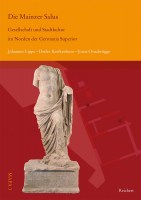Short Description
The volume at hand introduces a slightly less than life-size female figure with naked torso and hip cloak made of sandstone that was found in the “Zollhafen” of Mainz in October 2020. Her left foot rests on a bovine head, and a snake coils towards her left hand from her left shoulder. The inscription on the plinth identifies the figure as a “Salus”, donated to the inhabitants of the Mainz canabae in 231 AD by Senecionius Moderatus and Respectius Constans. Together with a sculpture from Cologne, the Mainz Salus forms a statue scheme adapted to local needs, the origin of which we place in the Flavian period and hypothetically associate with a newly founded cult at that time. Furthermore, the statue’s origins can be easily traced. The stone was probably quarried in the Nahe valley and imported to Mainz, where a workshop known to have distributed across the the province produced statues, presumably including the Genius from Nida (Heddernheim). With such products, the workshop catered to particularly ambitious clients, who adorned cities across Upper Germania with statues of various deities of salvation presented in public spaces, especially in the Severan period. Through this religious practice they both increased their own social prestige and contributed decisively to the urban added value of their communities. Finally, a second statue fragment found together with the Mainz Salus is presented and interpreted as Neptune.
Description
The volume at hand introduces a slightly less than life-size female figure with naked torso and hip cloak made of sandstone that was found in the “Zollhafen” of Mainz in October 2020. Her left foot rests on a bovine head, and a snake coils towards her left hand from her left shoulder. The inscription on the plinth identifies the figure as a “Salus”, donated to the inhabitants of the Mainz canabae in 231 AD by Senecionius Moderatus and Respectius Constans. Together with a sculpture from Cologne, the Mainz Salus forms a statue scheme adapted to local needs, the origin of which we place in the Flavian period and hypothetically associate with a newly founded cult at that time. Furthermore, the statue’s origins can be easily traced. The stone was probably quarried in the Nahe valley and imported to Mainz, where a workshop known to have distributed across the the province produced statues, presumably including the Genius from Nida (Heddernheim). With such products, the workshop catered to particularly ambitious clients, who adorned cities across Upper Germania with statues of various deities of salvation presented in public spaces, especially in the Severan period. Through this religious practice they both increased their own social prestige and contributed decisively to the urban added value of their communities. Finally, a second statue fragment found together with the Mainz Salus is presented and interpreted as Neptune.
Biographical Note
Johannes Lipps holds a chair of Classical Archaeology and is fellow at the Gutenberg Research College at the Johannes Gutenberg-Universität at Mainz. He studied Classical archaeology and ancient history in Marburg, Rome, Bonn and Cologne. He completed his PhD in 2008 at Cologne, which was followed by an assistant professorship at LMU Munich from 2009–2014 and a junior professorship at Tübingen from 2014–2019. His research interests concern architecture, urbanism and sculpture especially in ancient Rome and the provinces. Most recently, he published the monograph Die Stuckdecke des Oecus Tetrastylos im sog. Augustushaus im Kontext antiker Deckenverzierungen (Rahden/Westf. 2018).




 Preface
Preface

 Neuerscheinungen 2023/2024
Neuerscheinungen 2023/2024
 Gesamtverzeichnis 2023/2024
Gesamtverzeichnis 2023/2024
 Katalog Oriental Studies & Linguistics
Katalog Oriental Studies & Linguistics
 Mittelalter
Mittelalter
 Deutsche Inschriften
Deutsche Inschriften
 Musiktherapie
Musiktherapie
 Literaturen im Kontext
Literaturen im Kontext